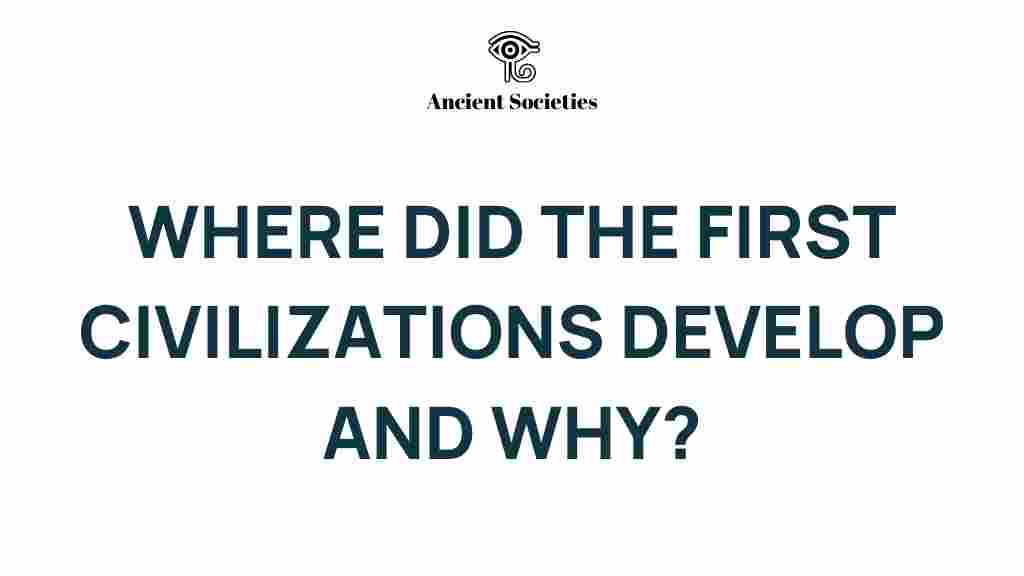Unraveling the Birthplaces of Ancient Civilizations
The quest to understand the origins of ancient civilizations is a fascinating journey through time, revealing how early societies developed and thrived in various regions of the world. This article explores the pivotal areas where these civilizations emerged, focusing on their historical development and cultural origins. We will delve into the significant contributions of Mesopotamia, the Nile Valley, and the Indus Valley, along with the archaeological findings that provide insight into these early societies.
The Cradle of Civilization: Mesopotamia
Often referred to as the “Cradle of Civilization,” Mesopotamia, located between the Tigris and Euphrates rivers, is where some of the earliest known complex societies formed around 3500 BCE. The region is known for its remarkable advancements in various fields, including writing, law, and urban planning.
- Geographic Location: Mesopotamia is situated in modern-day Iraq, southeastern Turkey, and western Iran.
- Significant Contributions: The Sumerians, Akkadians, Babylonians, and Assyrians were prominent cultures in this region.
- Inventions: The invention of cuneiform writing and the wheel are among the most notable achievements of this civilization.
The archaeological sites of Ur, Babylon, and Nineveh have provided invaluable insights into the societal evolution of these early societies. Excavations have revealed intricate pottery, ziggurats, and the famous Code of Hammurabi, showcasing the complexity of their social structures and governance.
The Gift of the Nile: Ancient Egypt
Moving westward, we encounter the Nile Valley, home to one of the most iconic ancient civilizations: Ancient Egypt. The rich alluvial soil along the Nile River fostered agricultural abundance, supporting a society that flourished for thousands of years.
- Geographic Advantage: The Nile provided consistent irrigation and fertile land, crucial for sustaining large populations.
- Cultural Developments: Ancient Egyptians made significant strides in mathematics, medicine, and architecture, evidenced by the construction of the pyramids.
- Religious Beliefs: The civilization was deeply religious, with a pantheon of gods and elaborate burial practices.
Archaeological discoveries, such as the tomb of Tutankhamun and the Great Sphinx, highlight the richness of Egyptian culture and its societal evolution, reflecting a complex social hierarchy and advanced governance systems.
The Indus Valley: A Mysterious Civilization
To the east, the Indus Valley civilization emerged around 2500 BCE, encompassing parts of modern-day Pakistan and northwest India. Known for its urban planning and advanced drainage systems, the Indus Valley remains one of the most enigmatic ancient civilizations.
- Urban Centers: Major cities like Harappa and Mohenjo-Daro featured well-planned streets and sophisticated architecture.
- Trade Networks: Evidence suggests extensive trade with Mesopotamia, indicating a level of economic sophistication.
- Writing System: The Indus script remains undeciphered, adding to the mystery surrounding this civilization.
Archaeological findings, including seals and pottery, indicate a rich cultural life, but much about their societal evolution and eventual decline remains unknown.
Comparative Analysis of Ancient Civilizations
When examining these regions, there are notable similarities and differences that illustrate the diverse paths of historical development:
- Geography: All three civilizations thrived near major rivers, which facilitated agriculture and trade.
- Social Structure: Each civilization developed a hierarchical social structure, although the specifics varied widely.
- Technological Advancements: Innovations in writing, architecture, and urban planning were common threads among these societies.
Understanding these aspects allows us to appreciate how early societies laid the groundwork for future civilizations.
Step-by-Step Process of Unraveling Origins
To comprehensively explore the origins of ancient civilizations, researchers follow a systematic approach:
- Field Research: Archaeologists conduct excavations in known ancient sites to uncover artifacts and structures.
- Analysis: Artifacts, such as pottery, tools, and written records, are analyzed to understand cultural practices.
- Dating Techniques: Various methods, including carbon dating, help establish timelines for the development of these societies.
- Comparative Studies: Researchers compare findings with other civilizations to draw connections and distinctions.
- Publication of Findings: Results are shared through academic journals and public forums to contribute to the broader understanding of cultural origins.
Troubleshooting Tips for Understanding Ancient Civilizations
While exploring ancient civilizations, researchers may face challenges. Here are some troubleshooting tips:
- Insufficient Data: When faced with limited artifacts, broaden the search to related sites or interdisciplinary studies.
- Deciphering Ancient Texts: Collaborate with linguists or historians specializing in ancient languages for better insights.
- Preservation Issues: Advocate for better preservation methods and support conservation efforts for archaeological sites.
Conclusion: The Quest for Understanding
The exploration of ancient civilizations, including Mesopotamia, the Nile Valley, and the Indus Valley, reveals the intricate tapestry of human history. Through archaeology and the study of societal evolution, we gain valuable insights into the cultural origins that have shaped modern societies. As we continue to unravel these ancient narratives, we not only honor the achievements of our ancestors but also enrich our understanding of humanity’s shared past.
For more detailed insights into the world of archaeology, check out this comprehensive guide. If you are interested in learning about other ancient cultures, visit our resources page.
This article is in the category History and created by AncientSocieties Team
